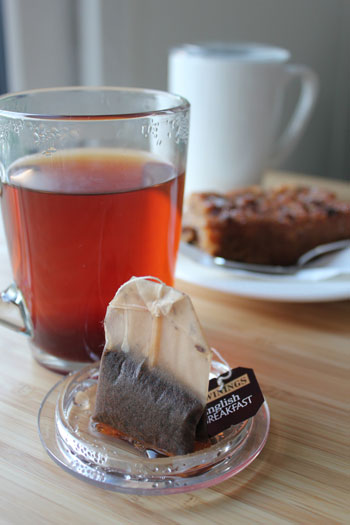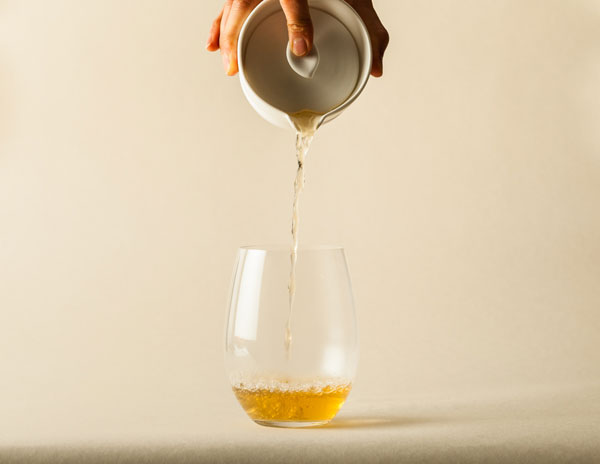Brews of the world: the success story of premium tea
The humble cuppa has come a long way in recent years, with premium tea consumption at an all-time high. Will Hawkes reports
Asparagus is one of those foods that keeps sommeliers awake at night. It's notoriously difficult to pair wine with asparagus, but there is one terroir that produces the perfect match: Nishi Garden in Kagoshima, Japan. But this part of Japan doesn't grow grapes, it grows green tea: Okumidori Kabusecha, to be precise.
"Tea and asparagus is a classic pairing," says Jameel Lalani, founder and owner of single-batch tea merchants Lalani & Co. The Kabusecha (‘shade-grown') is on the menu at Thomas's Cafe at Burberry in Vigo Street in London, alongside a dish of asparagus and poached egg. "The vegetals and the umami in the asparagus match what's in the tea," he says. "We're so used to drinking tea with sweet food, but actually in the whole spectrum of tea, there are a lot more matches for savoury foods."
It's a long way from the humble British cuppa, but tea is changing in the UK. According to a survey commissioned by food wholesaler Bidfood, 53% of consumers are now willing to spend more on a premium tea experience, while research by Tetley reveals that there has been a 3.6% year-on-year rise in out of home tea consumption.
"The mainstream media sometimes throw around the statistic that tea consumption is decreasing, but this doesn't tell the story of the tea revolution taking place in the UK," says Marco Geraghty of National Tea Day. "Tea consumption isn't decreasing; it's changing. Our research is telling us that younger consumers in particular aren't drinking six cups of tea with milk and two sugars before they leave the house, but instead opting for fewer cups of premium tea instead."
Tea terroir
For Lalani, teaâs next revolution will happen in restaurants, not cafés. âTea is the other terroir drink,â he says. âIt is the only other drink that has the same history, provenance and seasonality that wine does â" and the ability to match with food. Itâs what people are looking for, what the dining industry is hoping to find. We got a lot of emails from people who donât drink or who are cutting back. Thereâs a gap â" what do you sell to people who are non-drinkers?â

The other five teas, though, are £5-£6 each, making them affordable for customers and retailers alike. âItâs not an expensive luxury,â says Lalani. âYour cost per serving for a very fine tea is going to be between 15p and £2.50, with most under £1.20. You can have the most beautiful Darjeelings from gardens 6,000 feet above sea level, or shade-grown Japanese green tea from an organic garden â" the best teas from the region â" and the cost per serving is low. Compared with wine or whisky, people can access the very best tea.â
One of the big successes of recent years has been matcha, a Japanese green tea where the leaves are dried and then ground to make a powder. Lalani & Co has been importing high-quality matcha for the past four years. âWe werenât sure it was going to sell â" now weâre shipping it very frequently,â says Lalani. âItâs important to remember that itâs a tea, not an ingredient. It has flavour notes, producers; that message has been lost. A lot of the matcha that comes into the UK is cooking matcha, they expect it at a low price and thatâs the end of it.â
An interest in better-quality tea is happening across the market. Taylors of Harrogate has seen a big increase in demand for speciality tea, according to out of home manager Natalie Cross. âWeâre seeing strong category growth in fruit and herbal, green and speciality black teas and are continuing to seek out new and different flavours for our product range to meet the demands of adventurous consumers wishing to expand their tea-drinking repertoires,â she says.
The trend-makers
Much of the interest in quality tea is thanks to the efforts of one company: Teapigs. Launched in November 2006, Teapigsâ focus on whole-leaf tea and pyramid-shaped bags was revolutionary. Investment from Tetley, the company the founders had worked for previously, helped them break into a market which, in the words of co-founder Nick Kilby, âwas an old-fashioned, gentlemanâs worldâ.
âBack in 2006, there was a food revolution going on, but not in tea,â says Kilby, whose company turned over £12m last year. âBut tea has huge diversity and authenticity; Teapigs was about wanting to change the face of the tea industry, to have a bit more fun. We wanted people to have access to better quality tea.
âWe wanted people to think more about tea â" itâs not just a cuppa. Thereâs a lot more to it than that, how you can prepare it. We wanted people to get more involved.
âOurs is not loose tea, but [itâs served] in what we call a tea temple. This method of serve had been around for a long time, growing in Asia and in the US; we were inspired by gourmet tea companies in the US â" why was no-one doing that over here? It was quality tea in a convenient format, with a brand people would engage with.â
Kilby and business partner Louise Cheadle were inspired partly by what was happening in coffee, he says. âWhen we launched, the coffee revolution had already happened,â he says. âIt was good for us because we could go to these new coffee shops and say, âYou have great coffee, but what about tea? You have a lot of customers who would choose tea, given the choice.â
âWhat pleases us is that now, on menus in coffee bars, gastropubs and restaurants, there will be more of a tea menu. It doesnât just say âteaâ. Out of home itâs still the poor relation to coffee, but tea has certainly caught on, with a younger age group too â" 10 to 15 years ago youâd associate it with grannies. Nowadays tea is up there. And some people are over coffee and they want something lighter and healthier, like matcha.â
This new younger drinker is behind the demand for better quality and variety, according to Twiningsâ shopper marketing manager Andrea Stopher. Theyâre also more interested in their health. âThey are increasingly savvy about calorie content and healthy ingredients,â she says. âHealth and wellbeing is still a driving trend out of home, which continues to influence consumer food and drink choices. One in five consumers intend to increase their tea consumption as part of a healthy lifestyle.â
Marshall Kingston, Tetley senior brand manager, out of home, agrees. âHealth remains a current key trend: consumers, in particular millennials, are creating an increasingly health-conscious generation. Tea is often chosen for its health and thirst-quenching benefits: green and fruit and herbal blends are growing by 5.6% and 2.5% respectively, and by promoting their health benefits to the under-45s, operators can tap into the current market trend and continue to drive sales.â
Is tea healthy? âItâs fair to say that itâs a healthier drink than its rivals,â say Lalani, âbut Iâm always cautious to make great claims. There is heavy evidence to support tea, but there are still only a few studies that have been conclusive. Without a doubt, though, itâs full of antioxidants and it has no calories.â
The proper kit
Coffee has seen a huge rise in the equipment an aficionado can buy, from the Aeropress to the Nespresso machine. Tea is a simpler drink to make, but there are still ways in which the experience can be improved, according to entrepreneur and inventor Roland Hill. Hill has come up with Teapy, a tea-making and serving mug that, he says, eliminates the most common problems with tea serving.
Teapy consists of two elements: a see-through glass mug and a glass lid, which sits on top of the mug and holds the string and tag, ensuring the tea bag doesnât fall in. When the tea is ready, the lid can be taken off and used as a tea tidy. Itâs in use at the Stables Kitchen, Bramall Hall, Stockport, where the response has been good. âWe converted from cup and saucer service to Teapy six months ago and have received only compliments from our customers and servers, who much prefer the reduced preparation time and ease of carrying,â says manager Amy Baker-Howell.
Boiling point
One essential piece of kit is a temperature kettle, according to Lalani. Different teas require different temperatures: Kabusecha, for example, should be infused at 60°C. âMy advice is always to go for the kettle or even the multi- temperature instant heaters, not the under-counter boilers,â says Lalani. âThey cost thousands and donât do as good a job as a domestic machine. You can go through plenty of domestic machines before you even touch the cost of a domestic boiler. So donât waste your money!â
Lalani also recommends that outlets have a single-serve vessel. âYou need the right equipment to infuse; if you go to a large hotel, they serve tea from a big silver vat. Thatâs terrible, because silver takes on the flavour of whatâs in there, so your fine Taiwanese Oolong is going to taste of mint.
âIf the vessel is too big, the first cup is OK, the second is too strong, the third is horrific. You need a single-serve vessel, in porcelain or glass. You infuse it and then you pour it out.â
You can be up and running for an initial outlay of between £300 and £1,000. âTea is a super-high-return section of your drinks list,â he says.
Training is crucial too; a bad serve can impair the finest of teas. âWe train people,â says Lalani, whose tea is available in 150 different restaurants and cafés around the UK. âItâs not hard to do, but establishments have to decide theyâre going to do it properly. Some people are stuck in their ways. Weâre not afraid of stopping an account if the staff are serving in a bad way â" weâve done that. Itâs important. The customer has to get the best.â
Whatâs next?
Lalani says that youâll soon find tea in all the places youâd expect to see wine. âEverything you see in wine is going to happen in tea,â he says. âItâs the new skill to have: for individuals and sommeliers to be able to talk about and know tea. If you can tell your Okumidori, if you know your different Darjeeling gardens, youâre ahead of the trend.â Not only that, but youâll be one step ahead of your rivals when it comes to finding a match for asparagus.
Contacts
Lalani & Co
National Tea Day
Taylors of Harrogate taylorsofharrogate.co.uk
Teapigs
Teapy
Tetley
Twinings



















